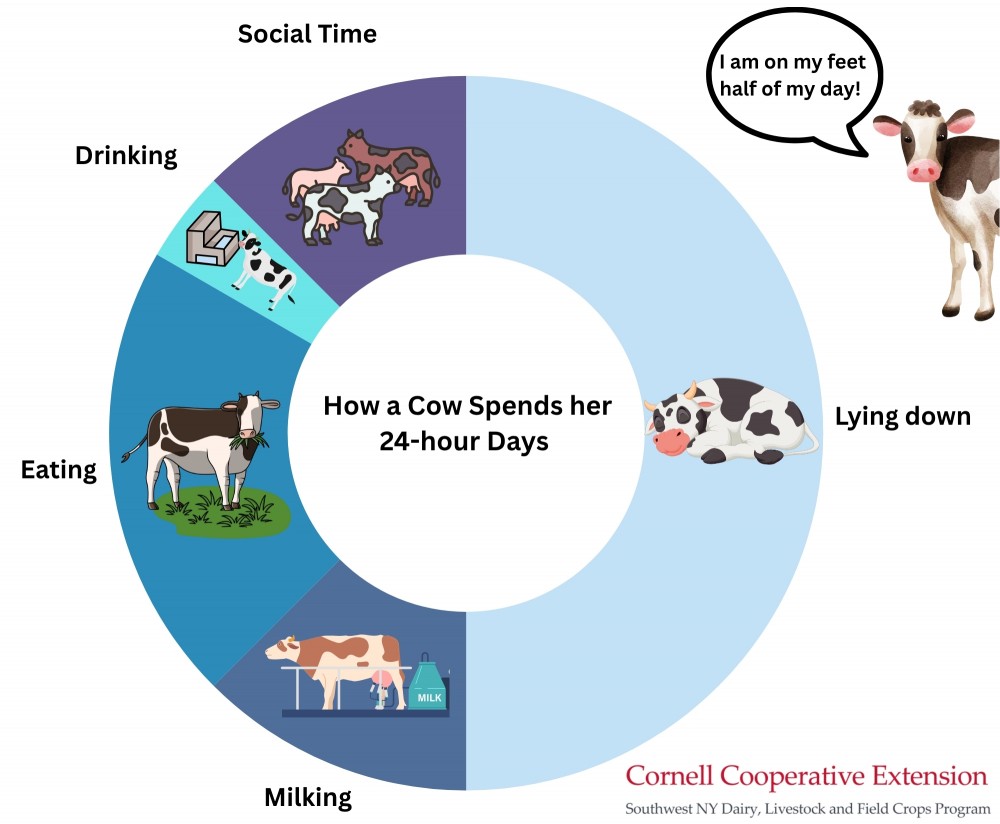Toe-tally Essential: Regular Hoof Trimming for your Dairy Cows
Katie Callero, Dairy Management Specialist
Southwest New York Dairy, Livestock and Field Crops Program
Are you wearing shoes? Unless you are cozied into bed right now, the answer is most likely yes. Typically, putting on shoes every morning is something we do without a lot of thought. That is, until we decide to try out a new pair of shoes and end up with a dreaded blister. Then all we can think about is the pain we feel in our feet. Most of the time, we don't want to walk in those shoes anymore, and we hurry to take them off to feel that sweet relief from pain. Yet our fellow four-legged friend, the cow, doesn't quite get that same luxury.
Lactating cows spend an average of 10-12 hours a day lying down. This means the other 12-14 hours of the day cows are on their feet, either standing or walking. A cow's hoof is very similar to our own fingernails. They are constantly growing. The normal growth rate of the hoof wall is about 7 millimeters per month. As cows walk, they can wear their hoof down naturally, but this wear is often inconsistent. It is either too much (overwear) or too little (overgrowth). Both of these issues can lead to lameness, which is when a cow changes the way she walks due to the pain she is experiencing.

Frequent and regular hoof trimming is imperative to prevent lameness. We shouldn't wait to call the hoof trimmer only when there's a problem. We want to prevent lameness for the health and welfare of the cows. Yet staying on top of regular hoof trimming can also prevent lameness before it ever happens and keep milk production high. Generally, cows should have their hooves looked at every 4-6 months, with trimming done as needed. Any cows that have foot lesions should be examined more frequently, every 3-4 months, as a history of foot lesions can affect hoof anatomy. This is why it is essential to record any hoof lesion data into your farm's recordkeeping system. Another option for a more in-depth foot trimming program for farms that don't have a lot of natural hoof wear would be examining a cow's hooves before calving, between 60-150 days in milk, and again before dry-off. Regardless of the program you choose, what matters most is that you have a regular hoof trimming schedule. Aaron Lavoy, owner of Midwestern Hoof Care and Trimming School, puts it best when he wrote, "The significance of lameness costs is often underestimated compared to the relatively small expense of prevention. The intent to save $1,000 frequently hinders the potential to generate $10,000 or more. I have witnessed numerous instances where investing more into hoof health yielded a return within a month that exceeded the annual cost or initial inputs. This is why hoof health should be seen as an investment rather than an expense."
If you have interest in SWNYDLFC hosting a hoof trimming training clinic in our region, please reach out to Katie Callero at 607-422-6788 or krc85@cornell.edu.
Upcoming Events
Crops, Cows & Critters - Southwest New York Dairy, Livestock & Field Crops Newsletter Sponsorship
December 19, 2025
Our two forms of publications feature research-based and timely information from our four specialists, listed to the right, along with local event notifications and Cornell University outreach. This information is provided to participants who range from dairy, livestock, and field crops producers to agricultural suppliers and consultants.
Weekly Email Update: Shared with 625+ households who have signed up with our program.
Monthly Paper Mailer: To reach our stakeholders and farmers who lack internet access, we send out a monthly mailer where your company's logo and contact information would be featured with a mailing list of 330+ households.
If you sponsor our weekly and monthly publications you reach approximately 955 households.
Visit our website to view our newsletters!
2025 Cornell Food Beverage & Animal Feed Manufacturer Survey
December 19, 2025
Industry and Educational Advocates for New York State's Food, Beverage, and Animal Feed Manufacturing industries:
As you know, NYS has a diverse food and beverage manufacturing industry, in both the types of industries that exist and the wide distribution of firms by scale. Many manufacturing firms have strong backward linkages to agricultural production sectors in the state that support both farm-level and downstream food industry firms and consumers. In collaboration with the New York State Department of Agriculture and Markets, a team from Cornell University's Charles H. Dyson School of Applied Economics and Management has recently rolled out the 2025 New York State Food, Beverage, and Animal Feed Manufacturer Survey. The industry will benefit from an updated assessment of the industry that informs private and public investments and opportunities to support firm growth and improved profitability.
Cornell Organic Field Crops & Dairy Conference
March 6, 2026
Waterloo, NY
Farmers, researchers, educators, and agricultural service providers from across the Northeast are invited to the 2026 Cornell Organic Field Crops & Dairy Conference, held Friday, March 6, 2026, from 8:00 a.m. to 4:30 p.m. at the Lux Hotel & Conference Center in Waterloo, N.Y.
Co-hosted by New York Soil Health and Cornell CALS, the annual conference brings together leaders in organic grain, dairy, and livestock systems to share practical tools, new research, and farmer-tested strategies to support resilient and profitable organic production.
Announcements
No announcements at this time.





